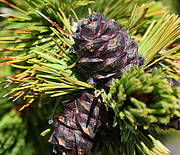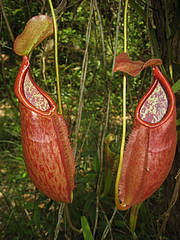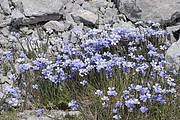
24 Jul, 2013
World’s oldest and largest species in decline – IUCN Red List
Geneva, 02 July 2013, International Union for Conservation of Nature news release – The latest update of The IUCN Red List of Threatened Species shows worrying declines for conifers – the world’s oldest and largest organisms – freshwater shrimps, cone snails and the Yangtze Finless Porpoise. The Santa Cruz Pupfish, a lizard known as the Cape Verde Giant Skink and a species of freshwater shrimp have been declared Extinct.
With this update, 4,807 species have been added to The IUCN Red List bringing the total of assessed species to 70,294, of which 20,934 are threatened with extinction.
“Thanks to the IUCN Red List, we now have more information on the state of the world’s biodiversity than ever before,” says Jane Smart, Global Director, IUCN Biodiversity Conservation Group. “But the overall picture is alarming. We must use this knowledge to its fullest – making our conservation efforts well targeted and efficient – if we are serious about stopping the extinction crisis that continues to threaten all life on Earth.”
The update includes the first global reassessment of conifers. According to the results, 34% of the world’s cedars, cypresses, firs and other cone-bearing plants are

Whitebark Pine Pinus albicaulis
Photo: Dr Sally Aitken
now threatened with extinction – an increase by 4% since the last complete assessment in 1998.
The conservation status of 33 conifer species has declined, including California’s Monterey Pine (Pinus radiata) – the world’s most widely planted pine valued for its rapid growth and pulp qualities. The tree has moved from Least Concern – a category used for species at relatively low extinction risk – to Endangered, with main threats including feral goats and attacks by an invasive pathogen. Another conifer species previously classified as Least Concern, the Atlas Cedar (Cedrus atlantica) – native to the Atlas Mountains of Algeria and Morocco – is now Endangered due to over-exploitation. Its reduced population is threatened by various pests.
On the other hand, conservation action has led to improved status for the Lawson’s Cypress (Chamaecyparis lawsoniana). Once a heavily-traded species, the tree is now listed as Near Threatened thanks to improved management practices in California and Oregon, including planting disease resistant stock. If conservation actions continue, this conifer may be listed as Least Concern within 10 years.
“Conservation works and the results for the Lawson’s Cypress are reassuring,” says Aljos Farjon, Chair of the IUCN SSC Conifer Specialist Group. “However, this is clearly not enough. More research into the status and distribution of many species is urgently needed. We suspect that there are many new species waiting to be described but it is likely that they will never be found due to the rate of deforestation and habitat conversion for oil palm plantations.”
Conifers are the oldest and largest species on the planet. TheBristlecone Pine (Pinus longaeva) for example, can live to an age of nearly 5,000 years and the Coast Redwood (Sequoia sempervirens)grows to a height of 110 meters. Apart from wetlands, coniferous forests sequester more carbon than any other biome – three times the amount sequestered by temperate and tropical forests. Their economic value is immense: softwoods are used for timber and paper production and the anti-cancer agent Taxol® is derived from the bark of many of the Yew species.

Rosette Pitcher Nepenthes suratensis
Photo: Shawn Mayes
This update of The IUCN Red List provides results of the first-ever global assessment of freshwater shrimps, of which 28% are threatened with extinction. Ten percent are used for human consumption, including the Giant River Prawn (Macrobrachium rosenbergii), and they are an important part of the freshwater food web. Pollution, modification of habitat and the aquarium trade are some of the primary threats they face.
Cone snails, found in tropical marine environments, have also been assessed for the first time, with 8% threatened with extinction. As predators, they are an important element in marine ecosystems and are highly valued for their lethal toxins which are used in the development of new drugs to treat intractable pain. These animals also have beautiful shells which have been collected for centuries, with some rare species changing hands for thousands of dollars. Habitat loss and pollution represent the greatest threats to these species.
“This assessment is a milestone due to an innovative cooperation between the shell-traders and scientific experts,” says Howard Peters of University of York, member of the IUCN SSC Mollusc Specialist Group. “Their joint work has provided new insights into the distribution, trade and threats facing each species. This is key to our future conservation efforts.”
Also assessed is the Yangtze Finless Porpoise (Neophocaena asiaeorientalis asiaeorientalis), a subspecies of the Narrow-ridged Finless Porpoise and one of the world’s few remaining freshwater cetaceans. It is found in China’s Yangtze river and two adjoining lakes, Poyang and Dongting. Its population, estimated at about 1,800 in 2006, has been declining by more than 5% annually since the 1980s and it has been assessed as Critically Endangered. Increasing threats to these porpoises include illegal fishing, intense vessel traffic, sand mining and pollution.
The White-lipped Peccary (Tayassu pecari) – a member of the pig family found in Central and South America – has declined by 89% in Costa Rica and 84% in Mexico and Guatemala and is now listed as Vulnerable. Hunting and habitat loss explain some of the decline but many cases of mysterious disappearance of the species have been documented in several regions with disease suspected to be the primary cause.

Linum katiae
Photo: Domenico Puntillo
Three species have been declared Extinct. Last seen in 1912, the Cape Verde Giant Skink (Chioninia coctei) – a lizard that was restricted to a single island and two smaller islets – was driven to extinction by introduced rats and cats. The Santa Cruz Pupfish (Cyprinodon arcuatus) – once found in the Santa Cruz River basin in Arizona – is now Extinct due to water depletion, and the Freshwater Shrimp Macrobrachium leptodactylus was a victim of habitat degradation and urban development.
“Once again, an update of the IUCN Red List provides us with some disturbing news,” says Simon Stuart, Chair of IUCN’s Species Survival Commission. “However, there are instances of successes. For example, increased survey efforts in Costa Rica have uncovered new subpopulations of Costa Rica Brook Frog and Green-eyed Frog. Sadly, much more needs to be done as the overall trend to extinction continues in many species.”



Liked this article? Share it!